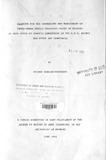| dc.description.abstract | The growth of Nairobi, both in terms of size and
density that today stands at 690 Km and 1.7 million people
respectively has been accompanied with diverse problems in
the planning and management of its urban sub-systems. One
such problem has been in the area of the provision of
adequate transport services, in particular the public
transport segment.
The level of intra-urban activities generated by a city
of such magnitude and density and with 73% of its population
having no personal vehicles demands that it be supported
with a well developed and efficient public transport system
to sustain the growth and development of the urban economy.
This study examines some problems in spatial planning for
public transport in a situation where an informal mode of
public transport .('Matatus')compete with formal public
transport modes, Kenya Bus Services and Nyayo Bus Services
and where the physical facilites provided for these modes
are not adequate to accommodate the levels of demand raised
thereof. The result has been heavy congestion and conflict
on the C.B.D roads, bus- stops and terminals used by these
modes. There is also competition for passengers that takes
place on the city roads, as these modes operate on the same
routes and have common destinations in the residential
estates.
This study describes in brief the present state of
these modes in terms of their role in public transport and
in details, how their needs are catered for in terms of
provision of the supportive physical facilities in the form
of bus stops and terminals.
The study provides evidence to show that the facilities
are inadequate to cope with demand and that the
difficulties encountered in trying to provide for these
modes is as a result of policy oversight where the spatial
needs of Matatus were ignored in preference to promotion of
K.B.S. and where public transport planning was only
considered in terms of supply of the modes to meet rising
demand with only low priority given to planning for their
arrival and departure points in the city, Hence their
increase in number has not been matched with provision of
these facilities.
The planning aspect of this study is given in the form
of a plan for action that attempts to alleviate the
escalating congestion and conflict through a traffic
circulation system that seeks to make maximum use of space
in the C.B.D. and a rational distribution of terminal points
among the three modes. Policy recommendations are also
given that should help the general management of the
operations of the public transport modes in a way that they
will supplement and complement rather than compete with each
other. | en_US |

